![]()
![]()
![]()
Use LEFT and RIGHT arrow keys to navigate between flashcards;
Use UP and DOWN arrow keys to flip the card;
H to show hint;
A reads text to speech;
48 Cards in this Set
- Front
- Back
|
What is the RDA for glucose?
|
130 grams per day
|
|
|
What two monosaccharides are epimers of glucose?
|
Galactose and Mannose
|
|
|
What kind of bond is formed when fructose switches from a linear structure to a ring structure?
|
Hemiketal
|
|
|
What food has the highest glycemic index?
|
Instant oatmeal
|
|
|
What monosaccharide produces the strongest sweetness response in our tongue?
|
Fructose
|
|
|
What hormone gets pancreatic acinar cells to synthesize and release alpha-amylase?
|
CCK
|
|
|
What three fatty acids get produced by human gut bacteria when they digest dietary?
|
Acetate
Propionate Butyrate |
|
|
What country was the first to provide its citizens with information on the glycemic index of food and beverages?
|
Australia
|
|
|
What factors affect the glycemic index of starch?
|
Processing and cooking both impact how quickly starch is digested and absorbed.
- cooked vs. uncooked - processed vs. unprocessed - amylose vs. amylopectin - cooking time - cooking method |
|
|
What is glucose?
Where does it come from? |
Blood sugar
From a monosaccharide |
|
|
Why is glucose listed as an essential nutrient?
|
Because our brain burns about 120 grams of it each day
|
|
|
What two tissues burn about 2/3 of the glucose we ingest each day?
|
Brain and Muscle
|
|
|
What is the end product of anaerobic glycolysis?
|
Lactic Acid
|
|
|
When is a human going to start having problems (due to glucose)?
|
At 60, when the blood sugar (symptoms of hypoglycemia) get down to 60 mg/dl.
|
|
|
Know the cells that can only use glucose as a source of energy
|
RBCs, WBCs, Rena Medulla, Retina, Lens, Peripheral Nerves, Testes, Sperm cells, Placenta, and Fetus.
It is a critical source of energy in the pancreatic BETA CELLS and the BRAIN |
|
|
What glucose transporter is often called the Insulin-Dependent Glucose Transporter?
|
GLUT4
|
|
|
How do we trap glucose in cells?
Where? What is used? What is used in most other cells? What is needed to get it back out of the cell? |
Put phosphate on it (add phosphate)
In the liver and alpha beta cells of the pancreas Glucokinase is used Hexokinase is used Needs G6P to take phosphate off |
|
|
What can a cell do with glucose once it traps it?
|
1. Take the phosphate off and send it back out
2. Use it to form glycogen 3. Use it to form complex carbohydrates other than glycogen 4. Burn it (glycolysis) 5. Send it through the pentose phosphate pathway (all of the above are correct: rank them according to how likely any given cell is to use these 5 things to glucose) |
|
|
When the CDC draws blood from 36,000 randomly selected healthy Americans they find a confirmed thiamin deficiency in 18% of the blood samples.
What disease which results in death is caused by a thiamin deficiency? |
Beriberi
|
|
|
If you drink a soda that contains high fructose corn syrup with a meal, where is most of the fructose going to go to?
|
Used to form Triglycerides
|
|
|
Why is high fructose corn syrup worse than sugar?
|
1. Fructose reacts with protein 7 times faster than glucose
2. Fructose does not suppress appetite like glucose does 3. Fructose does not get leptin released from adipose tissue to tell your brain to stop eating 4. Bypasses the rate-limiting step in Glycolysis |
|
|
Why did Al Martini develop Hemolytic Anemia?
|
Sulfamethoxazole
|
|
|
What three enzymes in Glycolysis have to be reversed for Gluconeogenesis to occur?
|
Glucokinase
Pyruvate Kinase Phosphofructokinase |
|
|
How do we bypass Pyruvate Kinase so that we can form glucose in the liver?
|
Use Pyruvate Carboxylase and PEP Carboxykinase
|
|
|
Which of these amino acids CANNOT be used to form glucose?
|
Leucine
|
|
|
What inhibits Phosphofructokinase (PFK-1) while stimulating Fructose 1,6-bisphophatase?
|
Citrate 2,6-BP
|
|
|
LECTURE #6 SLIDES TO KNOW
|
Slide #24 - know the rate limiting enzyme that controls the whole thing (for Glycolysis = PFK and for Gluconeogenesis = Pyruvate Carboxylase)
Slide #31 |
|
|
LECTURE #7 SLIDES TO KNOW
|
It is good to know how we put glycogen together.
Phosphofructokinase (regulation/control) Slides #7 key point - liver prefers AA and brain wants med. chain #15 (alpha1,4, alpha1,6 bond for glycogen - lasts for 4-6 hours on Atkins, 6-12 average, 12-24 high carb in liver) #25, 27 (CORTISOL!), 38, 50 (4 hormones do), 53-56, 75 |
|
|
Glycogenolysis enzymes
|
1. Phosphorylase = RATE LIMITING STEP!
2. Transferase 3. Debranching - cut alpha1,6 and has 2 activities (alpha1,6 glucosidase and transferase) 4. Phosphoglucomutase: G1P-G6P 5. G6P: liver, kidney, gut (makes vesicles - DOES NOT NEED A TRANSPORTER!) |
|
|
Where does Glycolysis occur?
|
In the cytosol
|
|
|
Rate Limiting Steps/Enxymes (HE LOVES THESE!!!!!)
In Glycolysis? What step do pancreatic alpha and beta cells use as the RLS in Glycolysis? In Gluconeogenesis? |
PFK
Glucokinase Pyruvate Carboxylase |
|
|
Which Gluconeogenesis substrate is most easily convertible to glucose and what is its glycemic index?
|
Mannose
GI = 37 |
|
|
Nona Melos
|
7 month old girl, GI distress w/ fruit juice
CSID (Congenital Sucrase-Isomaltase Deficiency) 1 in 5000 autosomal recessive Greenland & Canadian Inuit - 10% severity - depends on amount symptoms: diarrhea (pH<6), increased breath H+ >10ppm, negative lactose breath test Jejunal biopsy - to confirm Girl did not have CSID - possible fructose transporter defect Does not involve GLUT5 gene defect |
|
|
What is the normal serum glucose level for adults?
Diabetics? Dogs? Cats? |
64-110 mg/dl
over 126 mg/dl 60-120 mg/dl 75-150 mg/dl |
|
|
Caloric Homeostasis
Lecture 7 - Slide 7 |
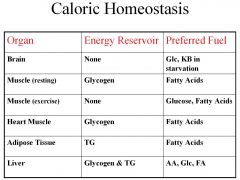
|
|
|
Structure of Glycogen
Lecture 7 - Slide 15 |
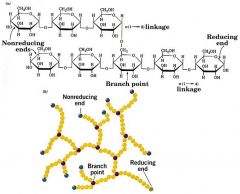
|
|
|
Causes of Hypoglycemia
Lecture 7 - Slide 25 |
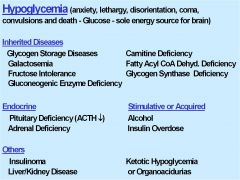
|
|
|
Hormones that Regulate Glycogen Breakdown
Lecture 7 - Slide 27 |
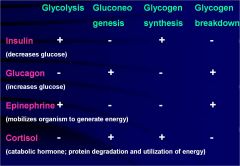
|
|
|
Insulin Control
Lecture 7 - Slide 38 |

|
|
|
Phosphorylase
Lecture 7 - Slide 50 |
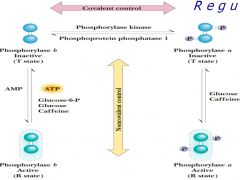
|
|
|
Glycogen Phosphorylase Inhibitors
(1 of 2) [Summary Slides] Lecture 7 - Slide 53 |
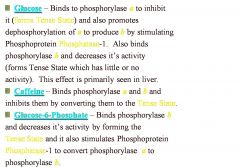
|
|
|
Glycogen Phosphorylase Inhibitors
(2 of 2) [Summary Slides] Lecture 7 - Slide 54 |
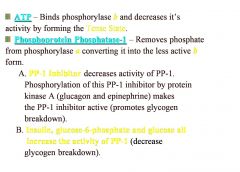
|
|
|
Glycogen Phosphorylase Activators
(2 of 2) [Summary Slides] Lecture 7 - Slide 56 |

|
|
|
Where is GLUT1 located?
|
RBC
Brain Muscle Fat Heart |
|
|
Where is GLUT2 located?
|
Liver
Pancreas Small Intestine |
|
|
Where is GLUT3 located?
|
Neurons
WBC Platelets |
|
|
Where is GLUT4 located?
|
Muscle
Fat Heart |
|
|
Where is GLUT5 located?
|
Intestine
Muscle Testis |

